Insect & Disease Conditions Update
Welcome all to the first issue of the 2015 Forest and Shade Tree Insect and Disease Condition Reports. We are looking forward to the upcoming growing season, especially so after the good old-fashioned winter we just experienced. However, the cool, slow spring this year may be used to advantage. The cool spring will likely provide some additional time to prepare for those early-season treatments required for a number of pests and pathogens. Tree and woody shrub phenology (timing and rate of budbreak and shoot development) as well as development of some insect pests will likely lag behind development dates observed in recent years.
Note the words ‘good old-fashioned winter’. Insects that live in Maine are used to cold and snow and will have done just fine getting through the season. Some of the invasive insects are more affected; check the hemlock woolly adelgid and winter moth reports for winter impacts on those populations.
There has been a good deal of winter injury and salt damage to roadside trees that has started to become apparent in the past few weeks. This damage may be quite visible for another month or so. Most of the conifer needle browning evident along streets and highways is the result of roadside salt spray, from which most affected trees will recover.
As in past years, diagnostic assistance for forest and shade trees and other woody ornamentals will be available from our insect and disease clinic, along with our Conditions Reports. And as always, we invite you to assist with our mission. We ask you to be vigilant and to report to us any observations on tree insects and diseases of concern to you. We appreciate your willingness, expertise and commitment to help keep our trees and forests healthy, and look forward to working with you this season.
Laboratory Hours
Our business hours for 2015 will be 7:30 a.m. to 4:00 p.m. Monday through Friday, except for holidays. However, due to a very busy field schedule, we may not be able to staff the Insect and Disease Lab at all times. If you call our Lab and receive no answer, please call back another time. And if you plan to visit the Lab, you may wish to call ahead just to make sure someone will be present to meet with you.
If you have questions on insect and disease pests of trees, you can now submit a clinic form directly on-line. We will also accept samples mailed in to our Lab in Augusta. Our street address and location remains the same (50 Hospital Street, Augusta); our mailing address is 168 State House Station, Augusta, 04333-0168. Lastly, we have attached the following items to this report for your use: Contact Information; Insect and Disease Diagnostic and Report Form.
Insect and Disease Management Staff Notes
In late September of 2014 we welcomed Regina Smith to the lab in the Entomology Technician position which had been filled earlier in the year by Jocelyn Lahey. Regina comes to us from the University of Maine with a keen interest in entomology. Regina’s capstone project and employment at the University allowed her to uncover her passion for the study of insects. She has broadened that experience since she started at the lab—sorting samples from beetle and light traps; participating in a week-long Asian longhorned beetle detail in Worcester, MA; deploying and collecting winter moth traps and then dissecting their catch; conducting survey for browntail moth and elongate hemlock scale and locating sites for emerald ash borer traps among other tasks.
Since January, we have had the pleasure to welcome Julie Churchill back to the lab. She has been working full time here this semester while she finishes up her last course in the forestry program at the University of Maine. Julie’s previous experience at the lab and great work ethic are a welcomed asset. We will take advantage of her forestry and entomology knowledge and experience as long as she’ll stay here, although she tells us she would like to find employment more aligned with her career goals once she completes her degree in May.

In December of 2014 Mike Skinner of Crystal retired from the Maine Forest Service after four decades with the state. Mike came on when spruce budworm was a problem back in the seventies and did everything from pole pruning branch samples to running a helicopter spray base. He then continued on in entomology, surveying the northern part of the state for insect and disease problems. Mike worked on the North American Maple Project, Forest Inventory, Forest Health Monitoring, Brown Ash Evaluation, Larch Canker Study and many more. He ran survey trapping projects in northern Maine for gypsy moth, spruce budworm, pine shoot beetle and other invasive insects. We could depend on Mike to do whatever task was sent his way with a joke and a grumble but always a smile and a laugh as well. We will miss his sharp evaluation of forest pest problems as well as his cooking.
We note with sadness the passing of Rex McBreairty in January and Everett “Skip” Cram in March.
Rex came to work for the division in 1963 as an Insect Ranger (now Entomology Technician), covering the old Ranger District 3 (west of the Allagash). Although he encountered and worked on a number of pest problems, the principal focus across his 20 year career was spruce budworm. When he retired in 1983 he had been involved with the whole gamut - from the early stages of build-up in the northwestern part of the state through to the beginning of the general collapse. After he retired he continued to be involved, operating a light trap in Allagash until recently.
|
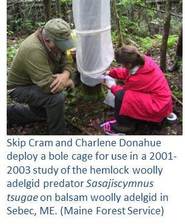 Skip worked for the Maine Forest Service for decades and was a valued Entomology Technician out of Medway. He is remembered not only for his stories but also the many contributions he made as an employee with this division. Part of his entomology legacy is the design of the bole cages used in a study of the development of the hemlock woolly adelgid predator Sasajiscymnus tsugae on balsam woolly adelgid. His cage design has been shared with others doing research in entomology—those constructed for the predator study remain ready for service.
|
Maine Invasive Species News
The Maine Invasive Species Network met in Hallowell in February of this year. The best way to describe this group is to steal from the website: “Maine Invasive Species Network (MISN) brings together research, education, and outreach professionals who work with invasive species in Maine.” If you are interested in learning about invasive species or if you work on invasive species in Maine you should check out their website. Two new features that grew out of this year’s meeting include an on-line calendar and a Facebook group.
Maine Natural Areas Program (MNAP) invasive plant biologist, Nancy Olmstead, was a part of the team that pulled this year’s meeting together. Nancy is a relatively new resource for invasive terrestrial and wetland plant concerns—she began working for the department last year. Nancy can answer your questions about invasive plant identification and management: (207) 287-8046 or nancy.olmstead@maine.gov. The MNAP maintains a website with many invasive plant resources. Shade-tolerant species such as buckthorn, glossy buckthorn, shrubby honeysuckles, Asiatic bittersweet, and others can become a problem in the forest, so keep an eye out for them. Also check out the online mapping tool iMapInvasives to map invasive plants on your property or public lands.
Insects
Browntail Moth (Euproctis chrysorrhoea) – The winter web survey indicates that the browntail population is expanding in range and intensifying once again.
Winter webs of browntail moth glisten in the sun this time of year. Look for them in southern Maine at the tips of host branches including oaks, apples, birches, cherries, hawthorns, roses and other hardwoods. Within the webs, caterpillars are ready to feed as soon as temperatures warm and buds begin to expand. Exposure to caterpillar hairs, even those from the previous year, can cause dermatitis and other health problems in sensitive individuals. Browntail moth larva feed on the new foliage in the spring and can cause branch dieback and sometimes tree mortality after repeated years of defoliation.
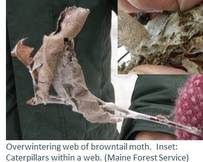 Winter web counts were highest again in parts of Bowdoinham, Bath, Topsham, West Bath (Sagadahoc County) Brunswick, Freeport and Harpswell (Cumberland County) this year. Browntail moth webs are also showing up in more southerly places including Cape Elizabeth, Scarborough, Westbrook, Windham, New Gloucester and Yarmouth (Cumberland County). We have seen pockets of infestation in other coastal locations from Lincoln County, south and in inland towns such as Augusta, China, Vassalboro, Waterville (Kennebec County), Lewiston, Turner (Androscoggin County), and Whitefield (Lincoln County). These spot infestations take less staff time, but if they are in your backyard they are noteworthy.
Small infestations can often be managed by clipping webs. Clip and destroy webs before the end of April (this is a fine winter activity when the woodstove is humming and the caterpillars are huddled in their webs, but a bucket of soapy water also works well). Pesticides are necessary to manage larger infestations. We have a list of licensed pesticide applicators that treat browntail moth and other pests of trees and shrubs available on-line or by request.
|
Christmas Tree Pests – Scout for balsam shootboring sawfly (Pleroneura brunneicornis) adults on sunny days in late April. If treatment is needed, it should be applied two weeks after adult activity is seen. See also this resource from the UNH Cooperative Extension Library.
Look for nymphs of balsam twig aphid (Mindarus abietinus) on the undersides of previous-year needles in the lower crowns of Christmas trees in early May. More details on important pests and management activities in Christmas tree plantations can be found on-line.
Eastern Tent Caterpillar (Malacosoma americanum) – Watch for the developing tents of these hairy caterpillars in cherries and apples in late-April and early-May in southern Maine (later as you move farther north). Consider removing the tents from valued ornamental and fruit trees while they are still small. Cornell University Extension has a video of this very hungry caterpillar at work on YouTube.
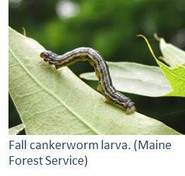 Fall Cankerworm (Alsophila pometaria) – Last summer there were reports of this hardwood defoliator feeding in conjunction with winter moth in the Harpswell/Brunswick area. This is a native insect that periodically appears in Maine in damaging numbers. In the past, outbreaks have been localized and lasted only three or four years. Trees that are heavily defoliated for two or more years can have reduced growth, branch dieback or tree mortality. With winter moth in the area, browntail moth returning and potentially another foliage feeding insect on the same trees we could see some significant problems arising.
This insect is similar to the winter moth and Bruce spanworm. The males fly in October and November - the females are flightless and climb up host trees to lay their eggs. The eggs overwinter and hatch in early spring as the buds begin to swell on the trees. The larvae are pale green to dark brownish-green inchworms that first feed on buds then skeletonize the leaves and finally eat all but the midribs. By mid-June the feeding is done and the larvae drop to the ground to pupate in the soil until late fall.
Emerald Ash Borer (Agrilus planipennis) – Emerald ash borer (EAB) has not yet been found in Maine. Purple trap surveys, biosurveillance sampling and trap tree processing and public reports have all yielded negative results in Maine (which is positive!). EAB has been found nearby in eastern Massachusetts (North Andover (Essex County)) and southern New Hampshire (Merrimack, Hillsborough and Rockingham Counties). Even though this destructive insect has been found on our doorstep, it is still too early to be treating specimen ash with pesticides to protect from this pest. Experts recommend holding off treatment until the EAB is within 10-15 miles of the trees in question.
|
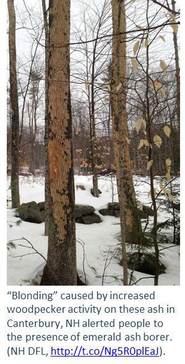 In the meantime, resources are better spent on inventorying ash and survey and monitoring for the pest. An ash inventory can be as simple as a windshield survey to determine whether you have boatloads of ash to worry about or just a few. Ash phenology gives us a great opportunity to conduct surveys as hardwood leaves emerge. Ash are among the last to leaf out (black locust is another slow-poke), and because of this characteristic are easily recognized after other hardwood leaves have flushed. If you are taking time to do a more in-depth survey, consider recording location, size, value and likely management approach for each tree. If you are going to remove an ash when it gets infested, you might want to consider pro-active removal, especially if you have a large tree which will produce huge broods of beetles. Check out the nhbugs.org site on EAB, for some succinct advice on preparing for this pest in areas more than 10 miles from known infestations.
Visual surveys can be conducted this time of year. Symptoms to look for include increased woodpecker activity, bark splits and excessive shoots. Signs such as larval tunneling, larvae or pupae may also be found in infested trees. After leaf out be on the lookout for crown thinning as well. Adult beetle activity is not generally expected until early to mid-June, in southern Maine.
Later this year, consider participating in our trap tree network or conducting biosurveillance in your town. More information on these two survey methods will follow in later reports.
|
 Gypsy Moth (Lymantria dispar) – Now is a good time to search for egg masses of gypsy moth around prized landscape trees and shrubs. Masses you find can be scraped into a bucket of soapy water. When pin cherries are in bloom, the caterpillars will be hatching. In southern Maine we should see them begin to hatch within the next couple weeks. Look for them soon if you intend to destroy them. In northern Maine, eggs in masses above the snow line should have experienced significant winter mortality.
If you find gypsy moth egg masses (or larvae later in the spring) in the northern ends of Oxford, Franklin, Somerset, Piscataquis or Aroostook County, please report your find, including the location and photos if possible to our office. An expansion of the quarantine area for this pest is planned—it takes a fair amount of resources to make the change, so we’d like to have the best possible picture of where the pest is established before we start the process.
Hemlock Woolly Adelgid (Adelges tsugae) – We have entered the time of year when hemlock woolly adelgid (HWA) can be spread on items other than live hemlocks. Eggs and crawlers will both be out and can be transferred to hemlocks in new areas. If you are working in both infested and uninfested areas, try to begin your day in uninfested sites, and end in infested sites. To avoid spreading this pest to new locations, clean clothing and equipment before moving from infested areas to uninfested areas.
Hemlock branch material from quarantined areas is regulated. Chipped material must stay inside the quarantine or be moved in an enclosed vehicle to a facility with a permit to receive regulated hemlock. Roundwood can be shipped freely outside of the quarantine area, but must be free from branches.
Winter mortality assessments were conducted in late February this year for a project in cooperation with Tom McAvoy at Virginia Tech. Mortality ranged from 84% to 98% across five sites, and averaged 93%. This is up from 2013-2014 when the range was from 67% to 87% and the average was 78. It may be a conservative estimate of above-snow mortality because sampling took place before some of the cold weather in late February. However, heavy snow cover will have protected some adelgid. Our partners in New Hampshire conducted assessments above and below the snow line and saw 100% mortality above the snow and 98% below the snow inland and 98% mortality above the snow 79% mortality below the snow in coastal regions. The good news is, infested trees should experience a reprieve from heavy attack, and spread of this insect should be slowed. Unfortunately, populations of adelgid building from this winter’s survivors may be more tolerant to winter cold than previous generations.
- York ME: 93.4% mortality
- South Berwick, ME: 97.1% mortality
- Cape Elizabeth, ME: 92.5% mortality
- Freeport, ME: 83.6% mortality
- Bath, ME: 97.7% mortality
- Average: 92.9% Range: 83.6% -97.7% N=150 live/2142 dead, 2292 total
Spring treatments may not be necessary for trees that are being treated with non-systemic materials. Adelgid wool can be persistent, be sure to check for live adelgid before conducting foliar applications. If you run your finger down a twig with live adelgid, it will be stained red from their hemolymph. Hemolymph of dead adelgids quickly turns brown, and then dries.
|
Northern Pine Weevil (Pissodes approximatus) – Pissodes approximatus looks approximately like white pine weevil, though the damage it can cause looks different. Its primary native host is red pine, it also thrives in Scots pine. It can attack eastern white, pitch, jack and Austrian pines as well as spruce species. The northern pine weevil is thought to be the culprit that killed several red pine saplings that were planted in Auburn near established red pine. Samples of damaged boles and a beetle were submitted in October, but the beetle escaped captivity before being delivered to the lab.
This weevil can survive well in stumps and larger slash of recently cut red pine trees. It readily attacks dead and dying trees and apparently healthy young trees. Damage can include complete girdling of the trunk above the root collar. Larger caliper transplants in recently harvested or declining red pine stands are the perfect target for this pest. Red pine in Maine is also under attack from fungal shoot blights and red pine scale. Alternative species should be considered for reforestation efforts adjacent to existing red pine plantations.
White Pine Weevil (Pissodes strobi) - Host trees of the white pine weevil include, as one might guess, white pine, but the beetle also has a taste for other pines and spruces. Often the calls we get from homeowners are regarding favorite blue spruces damaged by the beetle. Larval feeding can kill the host’s leader (terminal shoot), causing a loss of apical dominance, and can lead to development of a shrubby tree.
In southern Maine temperatures will soon climb high enough to trigger emergence of white pine weevil adults from their winter homes in the duff beneath their host trees. The adults climb up the host trunks and feed on the terminal shoots. Soon after, females will deposit eggs in the terminal shoots. Eggs hatch within a couple weeks and the larvae chew their way downward, cutting off the conductive tissue of the shoot and causing the shoot to wither and die.
Host leaders can be protected from attack by physical barriers and pesticides. A protective sleeve made from a nylon stocking and a twist tie is an easy, low-tech approach to preventing attack in small ornamental trees. Fasten the stocking before temperatures climb above 60 degrees Fahrenheit in the spring, and remove it before shoot elongation. See the early season guide for information regarding chemical controls.
See also: http://www.na.fs.fed.us/spfo/pubs/fidls/wp_weevil/weevil.htm.
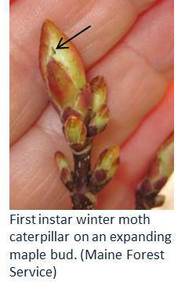 Winter Moth (Operophtera brumata) – Soon the tiny caterpillars of winter moth will be hatching and mining hardwood buds. The easiest way to track down the larvae at this stage is to inspect host buds for silk and specks of frass. Wait a few weeks, and the signature feeding damage will be evident on expanded host leaves. Like the cuts in a paper snowflake, the larval bites make holes through several layers of leaf tissue, giving the unfurled leaves a Swiss cheese appearance. Caterpillars will finish feeding by the end of May or early-June and drop to the soil to pupate.
Surveys and reports of adult winter moths flying in December of 2014 indicate that winter moth numbers were way down from 2012 and even lower than 2013. Low temperatures and snow/ice cover prevent the moths from mating and laying eggs. We may find that damage from winter moth is down again this year. Places that did have significant number of moths were Kittery, Vinalhaven, Harpswell and Cape Elizabeth. The towns of Bath, Portland, South Portland, Boothbay Harbor, South Berwick, Falmouth, Arrowsic, Georgetown and York need to be watched for increasing numbers in the future.
The biological control tachinid fly, Cyzenis albicans, was released in Kittery, Vinalhaven, Harpswell and Cape Elizabeth over the past two years. We hope some of the winter moth larvae will eat parasitic fly eggs. For those unlucky ones, the fly will develop within the winter moth cocoon, and prevent the winter moth from developing to adulthood. We will continue to release parasites where winter moth populations are high enough to support the control agent.
Diseases and Injuries
Animal Damage – Damage to trees and woody shrubs from animal browsing occurs not just during the deep snows of winter, but may continue well into early spring. Deer in suburban and rural areas especially have been hard-pressed to find browse this year. Often ornamentals including yews, arborvitae (northern white cedar), maples, and other hardwoods can be heavily browsed. Most browsed individuals will recover, but may need some pruning attention to reshape and restore their aesthetic appearance
Anthracnose Diseases – Oaks, ashes, maples, and birches are all susceptible to leaf anthracnose diseases. Some damage from several fungal pathogens, each specific to a tree species, is reported every year. Spring weather conditions of high moisture and humidity are the over-riding factors that influence the severity and incidence of leaf infection that occurs. During the past several years, Maine has experienced high disease incidence in oaks and birches, and some lesser damage to maples. Because the trend in wet weather appears to be continuing on into this Spring, careful consideration should be given to providing protection from these leaf pathogens, particularly in ornamental settings, with the use of fungicides. To be effective, fungicides need to be applied just after budbreak (usually around the end of the first week in May), and again ten to fourteen days later, to protect the newly-formed leaves. Due to the cooler temperatures this year to date, optimum application times may be slightly later than in years with warmer springs. Refer to the Early Season Guide for Pest Management for specific fungicide recommendations.
|
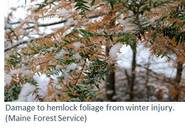 Hemlock Shoot Blight and Needle Damage – Symptom development in conifers damaged by drying winds or needle desiccation as a result of frozen soils becomes obvious during early spring, as temperatures warm. Observations were made this week of winter injury to hemlocks of all sizes in Sweden and in other towns in southwestern Maine. Symptoms include a light orange to yellow or straw-colored appearance to the needles. Older needles appear to be show symptoms first, with the shoot tips remaining green for some longer period of time. These symptoms may be seen in hemlocks well away from roadsides, where damage from road de-icing salts is unlikely to have occurred.
While inspecting hemlocks, be sure to note the condition of the shoot tips, as well. Browning, blackening, and curling of the shoot tips may indicate damage from hemlock shoot blight, a disease caused by the pathogen Sirococcus tsugae. The disease is widespread in Maine, and heavy infection levels over several consecutive years can result in severe defoliation and branch dieback. Ornamental hemlocks can be protected from shoot blight infection with fungicides applied during mid- to late May, as new shoot elongation develops.
Needle Diseases of Hard Pines – Early spring is the appropriate time to use fungicides to manage for several needle disease pathogens. Sphaeropsis (= Diplodia) tip blight of red, Austrian, and Scots pine, and Sirococcus shoot blight (Sirococcus conigenus) of native and exotic species of hard pines are all perennial problems. Protection of the new, current-season foliage with fungicides can provide effective control. Specifics for several of the most important diseases are listed in the enclosed guide.
The new growth (foliage, needles, and shoots) needs to be treated with the appropriate fungicide before infection occurs. This usually requires an application shortly after budbreak, and again ten days to two weeks later, to protect the new growth as tissues expand. Timing of the first application varies from year to year, depending on local seasonal temperatures. This year, expect budbreak to lag slightly behind our “average” year. Weekly observations of buds from late April through May will allow tailoring fungicide application timing to maximize effectiveness.
Spruce Needlecast – Just as with the leaf anthracnose diseases of hardwoods, wet spring seasons also provide ideal conditions for the intensification of Rhizosphaera needlecast infection on spruce, especially in landscape situations. The fungal pathogen (Rhizosphaera kalkhoffii) causes most significant damage to white and Colorado blue spruces, but other spruce species may be affected. Most frequently affected are border plantings of larger spruce, where trees provide a screen between abutting properties, but solitary trees may be affected as well. Symptoms typically develop from the bottom interior of the crown and slowly advance in an upward direction. Infected older needles turn a purplish-brown, and are shed first. Often, only the tips of the branches retain needles. (UM Extension Fact Sheet)
For effective control, at least two applications of fungicide are required; at half-needle elongation of newly emerging shoots, and again when needles are fully elongated. Fungicides will protect only the new, current-season shoots and foliage, so annual treatments over two or three years may be required to fully restore a dense, full tree crown.
White Pine Blister Rust (Cronartium ribicola) – Early spring is an ideal time to scout the woodlot for currants and gooseberries (plants in the genus Ribes), which serve as a host for the fungus which causes white pine blister rust. Ribes plants are some of the first vegetation to leaf out in early spring, thereby becoming easily located for removal or treatment.
Ribes plants, the primary host of white pine blister rust, will be one of the first understory plants to leaf out, usually by mid-April in southern Maine. There are several native species common throughout Maine. Because foliage of most other forest vegetation has not yet emerged, early spring is an ideal time to scout for Ribes plants. Located plants can be treated now (physically removed or treated with herbicide), or “flagged” for treatment at a later date. Ribes spp. eradication from around white pine stands has been an effective control measure for this disease since the practice was first initiated in Maine around 1918. Removal of all Ribes species within 900 – 1000 feet of susceptible pines or pine stands will greatly reduce the likelihood of infection of white pine by the white pine blister rust pathogen.
Some other New England states and New York have allowed the cultivation of Ribes specifically bred to be resistant or immune to the disease. However, a more virulent strain of the pathogen was discovered in 2011 in New England, and cultivars of Ribes once resistant or immune are now susceptible, and pose a significant risk of spreading the disease to white pines.
The importation, possession, planting, and culture of currants, gooseberries, Jostaberries, Worcesterberries and all other species of Ribes is prohibited by law in the quarantine area of Maine. In addition, the importation, possession, planting, and culture of any Ribes nigrum (European black currant) or its varieties or cultivars is prohibited throughout the entire state.
Winter-Damaged Plant – Suggestions for repairing winter-damaged woody plants include:
Prune out dead and damaged wood. Cut back broadleaf evergreens before the onset of new growth if foliage has dried out. Carefully trim away loose bark at any crack to where remaining bark is firmly attached to the tree. This trimming helps improve wound wood formation or callusing. Callus is cell tissue that forms to cover wounds.
Remove and replace plants that are no longer desirable landscape specimens or that are dead. If the plant was incorrectly sited at that location in the first place, do not repeat the error. Select a different plant that will tolerate existing environmental conditions.
Reduce stress on injured plants by fertilizing, watering during dry periods, controlling weeds and insects, mulching, and generally increasing plant vigor.
Reposition and stake plants that were blown over in winter storms if root damage is not too severe. The larger the plants, the less likely they are to survive such efforts. Treat as transplants for at least two years, paying close attention to proper fertilization, pest control, and watering.
The above information was taken from Winter Injury and Protection of Ornamentals by Barbara J. Bromley.
|
Calendar
Ash Tree Tagging – The Maine Department of Agriculture, Conservation and Forestry’s (MeDACF) Forest Pest Outreach Project is partnering with Merryspring Nature Center to conduct an ash tree tagging event in Camden this month. Details are under development, but the event will be held April 24th; more information will be posted under “What’s New?” on the site www.maine.gov/eab.
Forest Pest Outreach Training - The MeDACF Forest Pest Outreach Project and its partners are offering workshops to train people to recognize, report and spread awareness about the Asian longhorned beetle (ALB), emerald ash borer (EAB), and hemlock woolly adelgid (HWA) and other invasive tree pests. Three continuing education credits are available for licensed foresters and pesticide applicators. See the on-line calendar for details.
- May 5, 2015, Baxter State Park Headquarters, 64 Balsam Drive, Millinocket, ME. 10:00 am to 2:30pm. To register or for more information contact Amy Polyot at the Penobscot County Soil and Water Conservation District amy.polyot@penobscotswcd.org; (207) 941-1043.
-
May 19, 2015, Farmington, ME. See the on-line calendar for details.
- July 22, 2015, Whitneyville, ME. Details to follow.
Early Season Guide to Pest Management: the guide is not compatible with this eBulletin. It is available on-line.
Conditions Report No. 1, 2015
Contributors: Charlene Donahue, Allison Kanoti, Nancy Olmstead (MNAP), William Ostrofsky, Dave Struble, Colleen Teerling
|